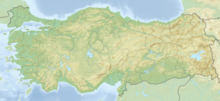Alinda (Caria)
Coordinates: 37 ° 33 ′ 30 ″ N , 27 ° 49 ′ 25 ″ E
Alinda was an ancient city in Caria , Asia Minor , about 25 km southwest of Çine in the Aydın Province , Turkey .
description
Alinda lies on two ridges above today's district town of Karpuzlu . In the lower town, the most striking thing is a former three-story building, the outer wall of the two lower floors of which is still completely preserved. It is 90 meters long and is interpreted as a row of stores and shops in the 30-meter-wide agora . The divided basement rooms are accessible from the valley side at ground level, the ground floor from the agora. Supports in the outer wall and several pillars occupy the former upper floor. The structure of the building is thus also reminiscent of large caravanserais with storage cellars, ground floor stables and living rooms on the upper floor.
Further up on the slope is the well-preserved theater . It is oriented to the southwest. The retaining wall of the auditorium (cavea) and the analemmas are made of Hellenistic ashlar masonry. On the uppermost plateau of the lower town are the foundations of a small temple of the Ante .
In the north of the upper town, a necropolis stretches across the flat mountain saddle. Numerous Carian sarcophagi stand in the landscape; many graves are also carved directly into the rock.
The upper town shows a solidly fortified upper castle in the west and the lower castle adjoining the slope to the east. On the southern slope there is a bastion in front of both, which is connected to the lower castle by a gate system. The wall ring of the upper castle, like the fortification of the lower town, is dated to the late classical period. Conversions and installations date from the Byzantine period.
In the west of the upper town there is an approximately 45 meter long section of an aqueduct . Four arches are completely preserved, next to them a section of wall with a gate. The water channel running on top is still covered by a few stones.
history
Much of the ancient ruins date from the 4th century BC. BC, especially from the reigns of Mausolus and Ada . The sister and successor of Mausolus resided from 340 BC. In Alinda after she was expelled from Halicarnassus by her younger brother Pixodaros . When Alexander the Great on his campaign in 334 BC Chr. Came to Caria, she gave him Alinda and offered him the adoption. He thus became the legal successor of the Carian rulers and set Ada as Queen of Caria after the conquest of Halicarnassus.
Alinda was still inhabited in Byzantine times and was the seat of a bishop, which lives on as the titular diocese of Alinda of the Roman Catholic Church.
Due to the similarity of the name and the location, an identity with the Hittite sources from the 14th and 13th centuries BC, presumed to be . Ijalanda, known to be located in southern Western Asia Minor, whose upper town was situated on a rock that was difficult to access, is uncertain.
Research history
In modern times, the British Richard Pococke was the first to report on Alinda from his trip to the Middle East during the years 1737–42. In the 19th century, William Henry Waddington , Philippe Le Bas and others followed with travelogues and drawings. In the middle of the 20th century, individual questions about the development of the settlement and building history as well as the necropolis were examined. So far, no excavations have taken place in Alinda. From 2007 to 2011 a survey project of the Institute for Cultural History of Antiquity of the Austrian Academy of Sciences ran in the ancient settlement of Alinda.
literature
- Gustav Hirschfeld : Alinda . In: Paulys Realencyclopadie der classischen Antiquity Science (RE). Volume I, 2, Stuttgart 1894, Col. 1489.
- George Ewart Bean : Alinda (Karpuzlu, formerly Demircideresi) Caria, Turkey . In: Richard Stillwell et al. a. (Ed.): The Princeton Encyclopedia of Classical Sites. Princeton University Press, Princeton NJ 1976, ISBN 0-691-03542-3 .
- Vecihi Özkaya: Alinda. An ancient city with its remains and monumental tombs in Caria. Revue des études anciennes 105-1, 2003, pp. 103–125. on-line
Web links
- From the χωριον of the 4th century v. To the Byzantine bishopric. Studies on the urban development and history of Alinda / Karien Alinda project of the Austrian Academy of Sciences
Individual evidence
- ↑ Lilli Zabrana: Alinda, Turkey. Temple in the lower city. In: Jahrbuch MSD 2007-09, Berlin 2009, p. 86 Archive link ( Memento from March 4, 2016 in the Internet Archive )
- ↑ Vecihi Özkaya: Alinda. An ancient city with its remains and monumental tombs in Caria. Revue des études anciennes 105-1, 2003, pp. 104f .; Alexander Herda: Karkiša-Caria and the so-called Ionian migration. In: Frank Rumscheid (Ed.): The Karer and the Others. Habelt, Bonn 2009, ISBN 978-3-7749-3632-4 (International Colloquium at the Free University of Berlin, October 2005), p. 54; more cautious ("perhaps"): Trevor Bryce : Letters of the Great Kings of the Ancient Near East. The Royal Correspondence of the Late Bronze Age. Routledge, London - New York 2003, p. 194
- ^ Max Gander: The geographic relations of the Lukka countries . Texts of the Hittites, issue 27 (2010). ISBN 978-3-8253-5809-9 . P. 197 (with further documents)
- ↑ Peter Ruggendorfer: The Survey Project "Alinda". In: Forum Archaeologiae 48 / IX / 2008





